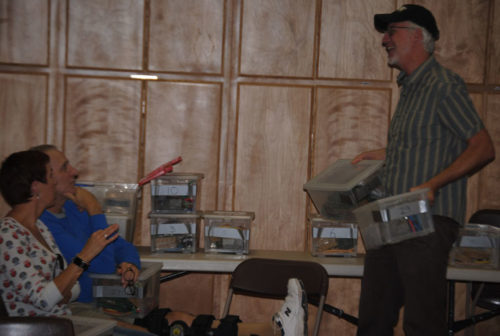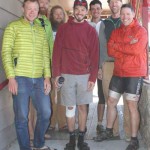
Photo by JP Crumrine
About 20 people volunteered to be “citizen scientists” in order to assess whether a flying squirrel population still exists in the San Jacinto Mountains.
Brian Gibson of the San Diego Natural History Museum was at the Idyllwild Nature Center Saturday to describe the project and distribute cameras to local residents interested in participating. A few camera kits are still available.
Among the attendees were Kerrie and Mondo Rodriguez, who said they often have “… eight or nine squirrels greet them every morning. We are very excited,” they said about the project.
“It’s a charismatic animal, and I’m surprised there are not more studies about it,” Gibson told the group. The flying squirrel is strictly a nocturnal animal with great eyes to collect the night light.
In 1908, Joseph Grinnell, on a survey of Southern California wildlife for the Museum of Vertebrate Zoology at the University of California, Berkeley, photographed and saved a flying squirrel specimen from the Hill, according to Gibson.
“Grinnell wrote in his notebooks nearly every night he heard the chuckling of the squirrels under the black oaks in Strawberry Valley,” Gibson said.
While the squirrels have been seen and mentioned since then, the last informal and unrecorded sighting was in the 1990s, Gibson said sadly. Since then, the species may have disappeared from the local environment.
Grinnell’s method of recording biological data (the Grinnell System) has become the procedure most often used by professional biologists and field naturalists, according to the University of California’s MVZ, where he was the first director.
Grinnell saw that the value of his work would be greater in the future than contemporaneously. He wrote, “… after the lapse of many years, possibly a century, the student of the future will have access to the original record of faunal conditions in California.”
A population of the Humboldt flying squirrel, which is the same species, still resides in the San Bernardino Mountains. For the past several years, the SDNHM has had a core group of citizen scientists photographing and recording the squirrels’ nocturnal lives in the San Bernardino Mountains.
Gibson shared slides and videos of the squirrels’ behavior captured by motion detection cameras — the same cameras he passed out Saturday.
“If all your sunflowers seeds are gone overnight, it could be a sign of the [flying] squirrels,” he said.
The indicators of their habitat, based on the San Bernardino population’s preferences, are a thick canopy cover, thick duff on the ground and a moist environment close to a water source, Gibson stated. And the SDNHM staff does not think flying squirrels hibernate.
In response to a question about why the squirrel population may not still exist here, Gibson could not identify any significant differences between the two locales.
One camera was reserved for the Mt. San Jacinto State Park. Gibson has had discussions with the staff about locating a camera at a higher elevation and possibly detecting the squirrels there.
However, a couple of more camera kits are available. After the first recording period is over at the end of September, there may be more, he said after the session.
The suet and nuts used to attract the squirrels into the camera’s perspective would seem to attract other animals. In San Bernardino, other species, such as fox and bear, were recorded along with numerous squirrel visits, perhaps attracted by the squirrels themselves.
If you are interested in obtaining a camera to try to capture a flying squirrel on film, Gibson can be reached through his email address at [email protected].










